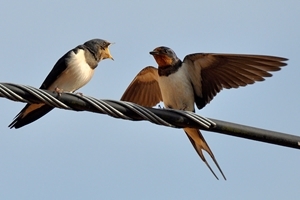Swallow
 Each spring when I see the first swallow (Hirundo rustica) of the year, I am reminded of the saying ‘one swallow does not a summer make’. But I think the saying should go on to say ‘but it doesn’t half lift the spirits!’
Each spring when I see the first swallow (Hirundo rustica) of the year, I am reminded of the saying ‘one swallow does not a summer make’. But I think the saying should go on to say ‘but it doesn’t half lift the spirits!’
There is something completely magical when, on hearing that chattering, twittering call, one turns to see the little bird, with its tail streamers, red face and white breast, sitting on the wires singing as if to say “I’m back!”
British swallows spend their winter in South Africa. They travel through western France, across the Pyrenees, down eastern Spain into Morocco, and across the Sahara. Some birds follow the west coast of Africa, avoiding the Sahara altogether.
Swallows tend to migrate mainly during daylight hours, probably so they can glean the odd insect as they go. They can cover around 200 miles a day, averaging speeds of around 20 miles per hour. Migration is tough on these birds, however, in particular the crossing of the Sahara Desert, which can be gruelling. Weather patterns can be helpful if the winds are favourable and the weather warm, but deep low depressions resulting in storms, rain and cold conditions can make the trip extremely perilous, and many will perish on the way.
Once they have arrived in their overwintering quarters, they will often communally roost in vast numbers in reed beds, such as at Mount Moreland situated on the north coast of KwaZulu in Natal, South Africa. Here, viewing platforms have been made for people to see the amazing spectacle of up to 3 million swallows coming in to roost.
However, we have not always known where swallows go to in winter. In the late 18th Century, naturalists across Europe became quite obsessed with the finding out the answer.
Most believed that swallows hibernated, in a similar way to amphibians, finding holes and cracks to hide in. Many tales supported this, such as the story in 1785 of farm workers, who while digging out a fox near Whitby, found “whole bushels of swallows in a torpid condition”.
Another common belief was that swallows went into ponds and waterways, over-wintering in the mud. This arose because folk saw the swallows roosting in the reeds beside the water in the evening but found that they had completely disappeared the following morning.
The famous Scottish surgeon John Hunter (1728-1793), who was also one of the most distinguished scientists of the day, decided that he would test this scientifically. So, during the autumn months he built an aviary in which he put some swallows, providing them with water, reeds and mud. His observations, coupled with the fact that he also looked at the birds’ lungs, showed him that swallows did not differ from other birds and would indeed drown if put under water.
Meanwhile, Gilbert White (1720-1793) the famous parson-naturalist from Selborne in Hampshire, was communicating by letter with fellow naturalists in Europe, and they had come to the conclusion that these fascinating birds did indeed leave to spend the winter months in warmer climes.
However, it was not until 6 May 1911, when a small aluminium ring numbered B830 was placed onto a swallow chick’s leg, located in a nest in the porch of Mr Masefield, a 61-year-old solicitor from Cheadle, Staffordshire, that the mystery of where these birds actually over-wintered started to unravel.
Some 18 months later, a letter dated 27 December 1912 was sent by Mr C H Ruddock, proprietor of the Grand Hotel, Utrecht, Natal, South Africa. He wrote:
“Dear Sir, On December 23, a swallow was caught in the farmhouse of the farm Roodeyand, 18 miles from this town, with a metal label round its leg, with the words Witherby, High Holborn, London, and on the other side B830. The farmer, Mr J Mayer, took the label off and has it in his possession. As I am interested in birds of any sort and the migration of same, I shall be glad to know if you received this letter safely.”
So, all was revealed – the birds flew some 6,000 miles on migration between the UK and South Africa twice a year!
There is one species that does not welcome back the swallow to our shores, I believe, and that is the sparrowhawk. Once swallows have started to nest, they constantly patrol the locality hunting for insects, but their beady eyes quickly pick up the shadowy outline of a hunting sparrowhawk below, well before all other birds, and immediately their screaming alarm call warns all birds that the hawk is about. They must be delighted when October comes and the swallows leave!
Finally, if you love swallows so much that you are thinking of getting a swallow tattoo, a word of warning. The swallow tattoo was traditionally a symbol that a sailor had returned home safely after a successful voyage. But it has also become a symbol that someone has spent time in prison. The tattoo is supposed to mean that you have ‘done your bird, done your time’. The ‘bird’ comes from the cockney rhyming slang ‘bird lime’ which means ‘doing time’.
So perhaps a sparrowhawk tattoo, then!
Peter Thompson
Advisory
Read more from Peter Thompson at his blog.